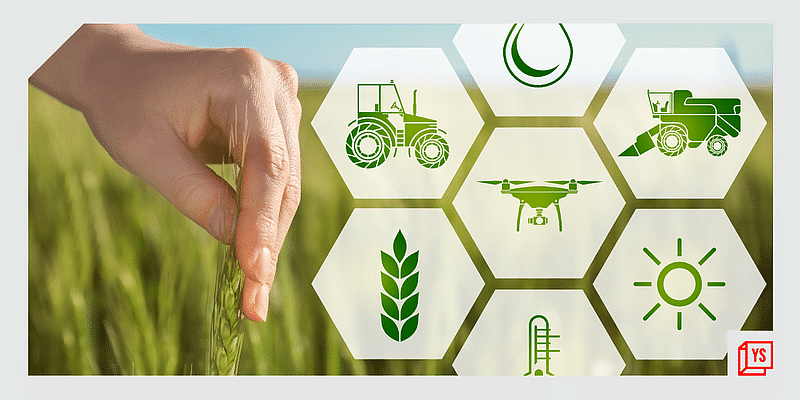Amidst climate change and food consumption habits dictating unsustainable production practices, how will we feed a growing population? The answer may not be in increasing resources – land, water, and crop types – but rather improving production efficiency to create more sustainable farming. The key question: How do we increase the amount of food we produce while using the same or fewer resources?
The security of the food systems is one of the world’s most pressing challenges. Consider this: If every person on earth ate the diet of an average American, that would require all the habitable land to be used for agriculture and we’d still be 38 percent short. And that’s the reality of today. What do we do when 2 billion more are added to our existing population? Think ‘efficiency’! Efficiency leading to a viable business proposition for small and marginal farmers.
Why precision agriculture is important
Enters Precision Agriculture. Precision agriculture could end up meaning a lot of things to a lot of people and most of them might also be true. In essence, precision agriculture brings efficiency in farm management to ensure that the soil and the crops receive exactly what they require to optimise health and productivity.
Let’s focus on the key driver of precision agriculture, which is data. Data-driven agriculture is the ability to first capture data from the farm and utilise data analytics to improve the ability to predict field conditions and weather events, which, otherwise, might not have been possible to either sense or accurately measure.
Weather anomalies have become more of a norm rather than an exception, where the driest summer has been followed by the wettest monsoons in decades, leaving agriculture in the lurch and the small and marginal farmers disproportionately affected. It has induced the need for drastic modifications to how cultivation is carried out.
What exists today as potential solutions for farmers starts with basic data analysis and evaluations, which then feed into solutions such as:
- Precision soil preparation such as ploughing, and levelling with the ability to customise the solution for specific requirements of the crop.
- Precision seeding, which executes optimum distance between seeds and depth at which it is sown and its ability to execute the job in a shorter period of time.
- Precision crop management with the ability to improve the effectiveness of applied solutions by maintaining specificity across crop variants, weather conditions, water utilisation and other external factors like disease and animal attacks.
- Precision Harvesting which measures the quantity of crops harvested at a specific time and location.
To achieve these results, we need remote sensing abilities, geo-mapping of the field, high precision positioning systems, smart sensors, and compatible IoT devices. These would form the foundational structure to initiate farm automation.
Overcoming challenges
However, for small and marginal farmers, adopting these solutions isn’t easy.
The lack of access to a stable internet connection is the first roadblock. A lot of these services depend on a stable network connection and the infrastructure needed to implement it isn’t uniformly available. The second roadblock is small land sizes. Other significant barriers include lack of local experts, Community Resource Persons (CRPs), and inadequate research. Affordability and accessibility to solutions, while currently an issue, is more likely to change with supply of solutions outpacing demand.
While agritech startups are innovating affordable solutions, their adoption at farm levels can be accelerated through government policies and CSR/Foundations who have the ability to mobilise resources. For a lot of these innovations, success hinges on how effectively they can be supported at early stages of development. This has a direct bearing on the effectiveness with which these innovations address the problems faced by the farming communities. Ecosystem enablers with the vision to recognise these shortcomings and the ability to bridge the various siloed support systems, play a vital role in the enablement and success of mission-driven startups.
Ways to facilitate tech adoption in farming
The first step to facilitate precision farming adoption involves identifying crops that tax our natural resources the most. It’s followed by the creation of a pool of local experts at the district or block level who can support the farmers to pilot and adopt technology at scale.
Agriculture focused programs like the India AgriTech Incubation Network (IAIN) and Krishi Mangal are playing a catalytic role in facilitating adoption of technological innovations that can significantly improve farmers’ yield and prosperity, while establishing sustainable practices. These initiatives bank on successful field demonstrations to inspire farmers to adopt these solutions at scale. IAIN and Krishi Mangal have made the technological solutions by startups more accessible by teaming up with partner agencies on the ground. Such engagement at the grassroots inspires a behavioural change among the users and can lead to sustained adoption.
Agriculture 4.0, the next green revolution, has science and technology at its heart. Envision a day when a smallholder farmer sitting at home could monitor their field on a smartphone, armed with data from multiple sources that help make informed decisions on the nature of crops and what time to sow. Imagine UAVs and automated/self-driven seed planters carrying out the tasks for these farmers. With precise weather forecasts, fertigation can be timed to improve the overall efficiency and efficacy.



![Read more about the article [Funding alert] Thrasio enters India with Rs 3,750 crore; buys appliance brand Lifelong](https://blog.digitalsevaa.com/wp-content/uploads/2022/01/CopyofImageTaggingNewBrandingEditorialTeamMaster-1642163147658-300x150.jpg)
![Read more about the article [Funding alert] Short video app Chingari raises $15M in Series A extension round](https://blog.digitalsevaa.com/wp-content/uploads/2022/01/funding-alert-short-video-app-chingari-series-a-extension-roundptcevpvb2.gif; charset=utf-8)





